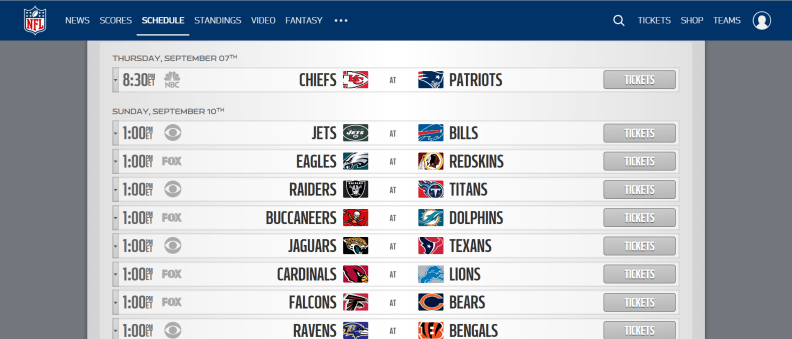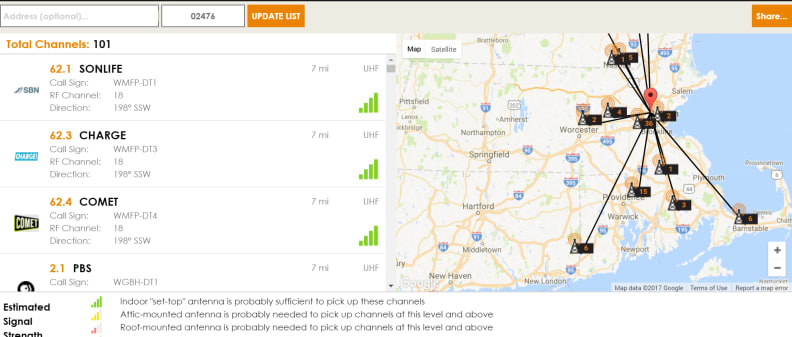Here's how you can watch all local NFL games this year for free—no cable necessary
There are many options for keeping up with your favorite NFL team, these are the best
Products are chosen independently by our editors. Purchases made through our links may earn us a commission.
Of all the major sports networks, the NFL has by far the most convoluted broadcast rules. With games split between three major networks—ESPN, streaming services like Amazon Prime, and its own NFL Network—it's tough to figure out exactly how to watch your favorite team.
While we have a comprehensive breakdown of how to watch every NFL game, the simplest way for most people is to use a broadcast antenna. While anyone over the age of 30 will remember TV antennas, a lot of people assume that broadcast TV disappeared when everything switched to digital.
But that's not true! In fact, broadcast quality has only gotten better since then. These days, most people around major metro areas can catch every headline broadcast network in crystal clear HD with nothing more than a cheap, low-profile antenna.
Best of all, this includes all NFL games that those stations broadcast. Any games on CBS, NBC, or Fox that haven't been blacked out are available over the air; all you need is an antenna to grab them. Here's everything you need to know.
What games can I watch with an antenna?
Any games broadcast by your local NBC, CBS, and FOX affiliates will show up with an antenna, and they should be the exact same ones that show up when you tune to those stations with a cable box. You can see the NFL schedule for week 1 here, with the assigned broadcasters. Note that these are subject to change later in the year, when games may be flexed between broadcasters.

The NFL publishes the broadcast carrier for every game every week, but you won't get every game in your market each week.
This typically includes four games on Sunday, including three afternoon games and Sunday Night Football. You'll get all the local team's games (excluding any that are only on cable channels like ESPN and NFL Network), but the other afternoon games will change from market to market. 506sports.com publishes weekly maps that show you which NFL games are coming to which market, that look like this:

This is the broadcast map from last season's early afternoon CBS broadcast, created by 506sports.com
Just note that which game you get over the air is determined by your proximity to the broadcast stations themselves, and not necessarily what market you typically live in. So if you live in the Baltimore area but can only pick up Philly stations, you may get Eagles games and not Ravens games. If you have a strong enough antenna you may be able to get both.
How do I know where my local stations broadcast from?
The most user-friendly broadcast tool is the digital TV reception guide, published on the FCC's website. Just enter your zip code and you can get a rough idea of which channels you receive and how strong the signal is.
A slightly more complicated, but more advanced tool is this map provided by Antennas Direct, a maker of DTV antennas. It works the same way, but it visualizes where your local stations come from and shows you the exact distances. Channel Master also publishes a guide that splits the difference between the two.

Channel Master's guide to your broadcast stations can show you how far away your local broadcast affiliates are.
This is important when it comes time to select an antenna for two reasons: First, you'll need to make sure you buy an antenna that's powerful enough to grab the stations you want. Second, you'll need to decide between a directional antenna (that grabs stations from roughly one direction) or multi-directional (grabs them from all around you). Most indoor antennas are multi-directional.
What antennas should I get?
{{ amazon name="Mohu Leaf 30 TV Antenna", asin="B00HSMK580", align="right" }}
For most people who have somewhat strong reception in their area and live within 35 miles of the stations they want, we recommend the Mohu Leaf 30 indoor antenna. It is a broad, flat antenna that sticks to a window or a wall and attaches to your TV with a coaxial cable.
Multiple people in our office (including yours truly) have used one for years, and I've never had any issues despite living on the backside of a very tall hill that sits between me and my local towers. Though stations have dropped once or twice on me, it was mostly during storms, and moving the antenna always fixed it.
{{ amazon name="1byone Indoor HDTV Amplified TV Antenna (50 Mile Range)", asin="B00RFLXE0A", align="right" }}
The one snag I've hit recently is that the Boston-area NBC affiliates have shuffled around. That means my closest NBC tower is 38 miles away. I still get it on most days, but not everywhere in my home. To compensate, I'm going to try to upgrade to this 50-mile model by 1byone, which has a signal amplifier and comes very highly recommended by experts and customers alike.
I live in an apartment now, but another option would be to use a stronger attic- or roof-mounted antenna. These can pull in tricky stations far better than the simple indoor antennas listed above. I don't have any direct experience with these but this GE-brand model is less than $30 and has 71% 5-star reviews on Amazon. It doesn't come with a coaxial cable, though, so you'll need one long enough to reach your TV from wherever you mount it.
How do I set up my antenna?
The optimal placement of your antenna will depend on what kind you get, but generally speaking indoor antennas will be mounted on an exterior wall or window within a foot of the ceiling. You'll then hook up a coaxial cable to that and run it directly to your TV's coaxial plug. Your particular antenna may come with other instructions, so see those.
Once hooked up, you just need to go to your TV's menu and scan for stations. How this process looks will depend on your TV but generally it will take a few minutes to cycle through all the possible stations and will then remember any that have signal coming in.
Most TVs have a digital tuner built in, so you'll be good to go. With very old TVs you'll need a tuner box that can decode the stations, such as this one. Note that some newer TVs don't have a tuner, notably some newer Vizio TVs. If you have a coaxial port on the TV, you should be good to go.
Can I record games?
Yes, but you will need more than just an antenna. The Tivo Bolt and Tablo DVR are two very popular options that each cost around $200. The Bolt can record four shows at once, comes with storage built in, and can access Netflix and the like but costs $15/mo for all its features.
{{ amazon name="Tablo 2-Tuner DVR for Over-The-Air HDTV with Wi-Fi", asin="B00MXUDD0O", align="right" }}
The Tablo DVR is a bit different. It hooks up to your antenna and can stream your broadcast stations over the internet. You'll need to add a USB drive to get the DVR functionality and it can only record two shows at once (there's a pricier 4-tuner version), but the monthly fee is just $5.
A third option is the Channel Master DVR+, which costs $249 and can record two shows at once. You'll want to add an external USB drive to record a full NFL game, but it has no monthly fees. I haven't used this one, but our colleagues at USA Today loved it.
Can I get 4K TV over the air?
Not yet. There are standards on the way that will allow stations to broadcast up to 4K, but we're nowhere near that yet. Even cable isn't very close to offering NFL games in 4K. Over-the-air broadcasts will work just fine on a 4K TV, but they'll be upscaled to fit the screen, same as games you receive via cable.
